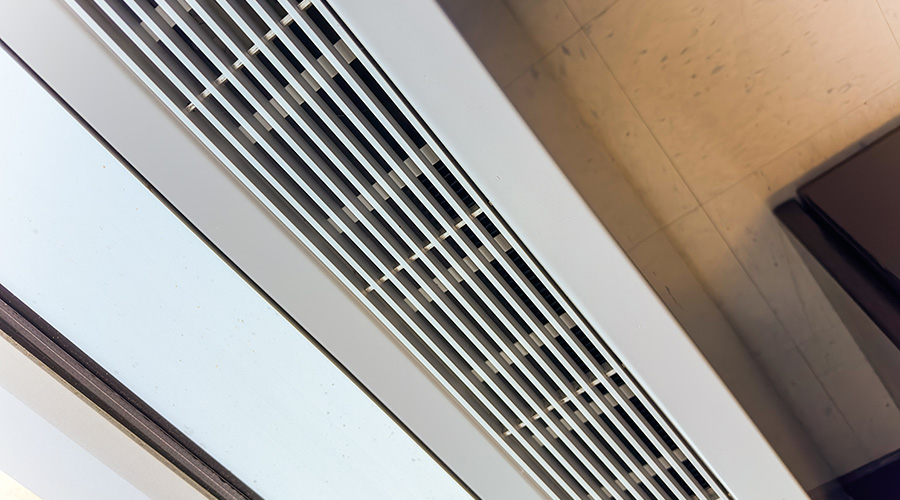The inside track on IAQ
Technology advances and comprehensive training give managers an edge in keeping indoor air healthy
The inside track on IAQ
In an effort to remediate visible mold on 15,000 books and counting, the University of Illinois in Urbana will have to close its rare book library for several months, according to published reports.
The university is not alone. Similar situations in various institutional and commercial facilities have caused irreversible damage, even after very costly remedies.
Managers can take steps to avoid them. Today’s testing and monitoring technology for indoor air quality (IAQ) puts more power than ever in the hands of front-line technicians diagnosing and addressing complaints and problems.
Managers seeking to develop a comprehensive strategy for preventing and addressing IAQ problems will need to remain up to speed on key advances in IAQ monitoring technology, understand the key components of an IAQ arsenal, and develop guidelines for technician training designed to maximize the organization’s investment in IAQ monitoring technology.
Technology advances
Key advances in IAQ monitoring technology most applicable to engineering and maintenance departments relate to the degree of accuracy of instruments now available. This increased accuracy applies to both the qualitative and quantitative aspects of IAQ measurement.
The latest generation of instruments can evaluate each particle and classify it by makeup — qualitative — and size — quantitative. This high-definition capability means solutions can be much more pollutant-specific and, therefore, much more effective in terms of remediation and cost. The knowledge gained by using the monitors leads to root-cause analysis to optimize efforts to control pollution.
For example, one relatively inexpensive laser particle counter can test for dust, mold, pollen, tobacco smoke, and dust-mite debris. The portable unit measures air quality and the effectiveness of heating ventilation and air conditioning (HVAC) filters.
Sensing devices include continuous fixed, hand-held portable and hand-operated sampling and sniffing units. Managers also now can choose from a growing range of material detectors.
Monitor advances also include wireless data transmission from remote sensor locations to a central station. This station can be a computer that accepts input from more than 50 locations and shows real-time status and alarm status.
An expanding array of do-it-yourself IAQ screen test kits are available. These kits check for mold, allergens, dust mites, formaldehyde, fiberglass, organic vapor and staphylococcus. The kits contain sample collection devices and lab analysis accredited by the American Industrial Hygiene Association showing actual versus permissible limits. Some can provide preliminary results in the field in as little as five minutes.
In terms of range, the organic vapor-screen test, for example, tests for room or individual exposure to more than 50 compounds, including acetone, benzene, hexane, mineral spirits, styrene, and toluene. When specifying any do-it-yourself air-screen tests, make sure they are state-accredited.
Problems and solutions
The objective of monitoring IAQ is to control air quality to ensure the health and safety of facility occupants and to protect valuable resources.
While many monitoring choices can test for multiple particulates, no one instrument can test for all of them. So deciding on key components for an IAQ arsenal begins with knowing the kind of air-quality issues and particulates technicians are most likely to encounter. This is the first step toward minimizing or eliminating them.
The question is, “How do I know what to test for so I can purchase the right devices?” The first method is sensory. Using sight, smell and hearing, technicians can find out a great deal about the environment. Sight can identify telltale wet spots and stains from mold, mildew and bird droppings, and stains on ceiling panels from roof leaks.
In one case, stains on ceiling panels in a cafeteria were growing until, one day, during a storm, several panels caved in and dumped several hundred gallons of water. The goal is to avoid letting the problem grow to that magnitude before fixing leaking roofs.
Smell also can detect mold, as well as many other irritants, including volatile organic compounds. During quiet times, hearing can detect dripping water, which can create chronic mold and mildew problems.
Knowing the outdoor environment is another key. What industries are nearby, and what pollutants do they generate? Absenteeism, especially when caused by respiratory problems, can indicate need to focus testing on bacteria and allergens.
Communication with peers in the region about IAQ issues also can reveal a great deal about common concerns. Some pollutants, such as radon, are odorless and colorless and require use of test kits to detect. Radon comes from uranium in the soil and can cause lung cancer, which kills thousands of people in the United States yearly. Managers can rely on statistics about radon’s presence in a given area to determine if such tests are warranted.
Generally, particles are formed by either mechanical or chemical processes and vary in size. Mechanically formed particulates form when larger particles break up into smaller pieces. Examples of mechanical particulates include dust and pollen produced from construction, agriculture, and fossil-fuel combustion.
Chemically formed particulates form gases, such as those emitted by burned fuel. In these processes, the pollutant vaporizes and condenses to a particle of the same chemical or combines with other chemicals to form a different compound.
Particle size can reveal a great deal about potential health risks. Environmental experts divide particles into two groups: smaller particles up to 2.5 microns and larger particles of 2.5-10 microns. Larger particles can stay suspended in air for minutes or even hours and travel distances generally measured in yards. Smaller particles can stay suspended for much longer periods — from hours to weeks — and travel for miles because they are smaller and lighter.
Smaller particles can pose greater health risks, not because of their ability to spread farther and longer but also because they can reach the deepest part of the lungs when ingested. They remain trapped there, or if soluble, enter the blood stream in minutes and shorten life spans, especially in people with already weakened respiratory systems.
Technician training
The most important content of IAQ courses for supervisors and technicians includes several must-have components to ensure they receive the training they need to maximize the investment in IAQ monitoring technology. The content should address various levels, such as orientation for supervisors and technical training for technicians.
Among the typical units are:
• causes of IAQ problems
• health risks from indoor air pollution
• methods for identifying IAQ problems
• methods for measuring pollution levels.
Since many people attending IAQ courses have very limited knowledge about the subject, the place to start is an introduction to the basics. These include statistics showing that people spend up to 90 percent of their time indoors, whether at home or in factories, health care facilities, schools, stores or other commercial and government buildings.
According to the Occupational Safety and Health Administration, 30 percent of Americans work in buildings with air pollution, and indoor pollution is far more concentrated than outdoor air pollution.
A well-organized introduction to IAQ provides participants with a proper mindset and motivation to take action. Following the introductory session, other course materials should address causes of IAQ-related health risks and cures, the role of a CMMS to gather IAQ cost/benefit data, and resources for further study.
Related Topics:











